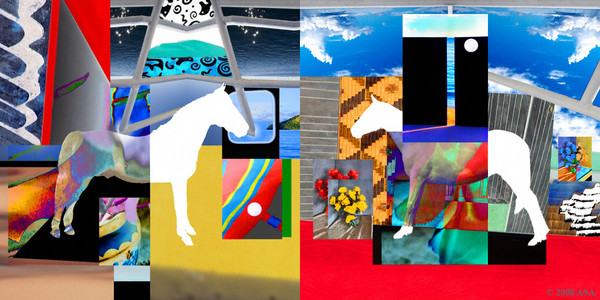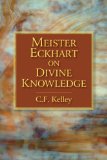“Tacit Glimpses”: A Review of Adi Da Samraj’s “Transcendental Realism” and “Aesthetic Ecstasy”
Page 4 of 4 pages « First < 2 3 4 - Full Article

Image: A Horse Appears In The Wild Is Always Already The Case, IV/1, 2006 (from Spectra Two)
As art history formed in the nineteenth century, it took its modes of classification from archaeology, botany, and zoology. Thus formed, art history was never purposed to convey an experiential state of mind, even though such experiences were embedded in the artist’s touch. These illuminated writings did appear, but not in the realms of formalist Western art history. Instead, they were found, from the Renaissance forward, in poetry, music, in biography and art theory, in the disciplines of anthropology, history of religions, psychology,—all forms that explored human experience. Suzanne Langer, Titus Burckhardt, Mircea Eliade, James Hillman, and others investigated the experiential transformation of feeling into form, and essence into image. The modern artists’ manifesto became a call to arms for disrupting the conventional view of art.
This breaking with convention is precisely the aim of Adi Da’s book. Alongside his philosophical stance, he outlines the spiritual intention of his art, staking out new ground in this important alternative body of knowledge. Not only rejecting historicist notions of progress in art, Adi Da also transcends mere critique to assert the power of art to transform the viewer’s actual experiential state.
The root of this transcendent art, Adi Da writes, is the radiance of a world penetrated and informed by a divine light:
I have no impulse to make and do art on the basis of ‘post-modern’ (or even ‘post-civilization’) cultural breakdown. This is why I worked so intensively to re-establish a basis for Reality-culture, a Truth-culture—before I could intensively make and do art within the context of an actual and living culture of Reality and Truth.
Before we can participate in truth and the beautiful as aesthetic experience, Adi Da says, our emerging world culture needs to be transformed by the possibilities of sacred energy, the Light that runs through all things. It is a mystical view that runs through both Western and Eastern cultures, from the biblical call to “see with new eyes”, to St. Francis Assisi’s understanding of the natural world as expressing divine presence, to the Chinese scholar-artists’ perception of the formlessness in form, to the transformative spaces of Monet or Rothko. This intuitive stance provides hope for romantic and mystical artists, hope that the essence of their work will become manifest.
That Adi Da challenges our culture to return art to its original, sacred purpose without merely recreating a long lost past makes “Transcendental Realism” a significant work, not only for artists but anyone who senses the limitations of contemporary culture and strives to create a more vivid way of being.
Celia Rabinovitch is an artist, writer, and teacher. Her paintings have been exhibited in solo shows in Canada, the U.S.A. and Europe, including Quattro, a four person international show in Vienna, Austria (2000), the Florence Biennale (1999) The Grotto Cycle, California Institute of Integral Studies (2003); Industrial Romance, University of San Francisco and
Gallery, Winnipeg, YYZ, Toronto; Emily Carr Institute; Plug-In and the Winnipeg Art Gallery. Her book, “Surrealism and the Sacred: Power, Eros, and the Occult in Modern Art”, 2002 uncovers new territory between the history of art and the history of religions. Celia Rabinovitch has taught art and cultural and art history at Stanford University, U. C. Berkeley, The California College of Art and the San Francisco Art Institute, the University of Colorado, McGill University and as a Visiting Artist at Syracuse University (1990). Born in Morden, Manitoba, she studied at the School of Art, University of Manitoba (B.F.A., B.A,) the University of Wisconsin (MFA painting) and McGill University, Montreal (Ph.D. history of art and religions). Currently she is Professor and Director of the School of Art, the University of Manitoba.
Page 4 of 4 pages « First < 2 3 4 - Full Article
Page {current_page} of {total_pages} pages {pagination_links}
{/simplepaginate}









